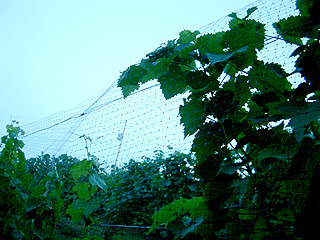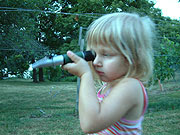
I have to admit that I felt completely ridiculous when I pulled my six dollar piece of laminated plastic out of the envelope. I wasn't really going to use this
Wine Wheel thing, was I?
I might pretend that describing a wine's aroma by comparing it to molasses, soy sauce, kerosene, geraniums, figs and so on is a strange thing to do, but in reality I'm just hesitant because there are plenty very good writers already doing it out there with wit and insight, including
this guy and also
this fellow. They can simply do it much better...what have I got to add?
But it occurred to me the other day that I'll have some gaps to fill in the winter. I can skim for interesting articles and talk about grafting or growing vines in your basement (I'm growing a row of ten Traminette from cuttings in the test vineyard, and some are already chest-high), but this blog will get stale with no new pictures to post from the vineyard. I'll be able to snap a picture or two of winemaking in the basement, but that's dull sport as making wine consists of 90% cleaning (unless you're a flying wine consultant and you zip around barrel tasting and reading lab samples, with other grunts doing the scrubbing).
But even after all that, I'm left with spaces to fill in the winter, and I don't want to lose the tiny audience I've managed to acquire, so I figured I'll write a few tasting notes when it's slow. After all, that's what it's all about, right...all of the time spent sweating in the vineyard and late nights in the cellar...it's about that glass of wine at dinner. I might as well pitch in my two bits.
Thus the Wine Aroma Wheel. Now I can use the right vocabulary like the big boys. We took the Wheel on a spin last night with a bottle of budget white Italian wine my wife found at the supermarket. A few weeks back I gave her strict ABC (anything but Chard) orders and she came home with a bottle of Mariana delle Venezie 75% Chardonnay and 25% Pino Grigio. It was lovely for a budget white, and when it warmed up to room temperature you could clearly distinguish both varietals. I consulted my trusty wheel, sniffed and pondered and came up with lemon peel, dried straw and a bit of butterscotch on the Chard. The oak, if any, was quite subtle, and it was a nice change all the way around. I've had some terrific budget Chards lately, including a 5-dollar Santa Barbara from Trader Joe's that had some surprising citrus and tropical fruit (Wheel!), but I'm tired of the malolactic fermentation, oak and extra sweetness that one usually finds in Chards in my humble price range.
So there you have it...my first ever tasting note blog. Look for more in the winter.
Tonight
in the vineyard I hauled a couple buckets up to water the new vines. The Traminette is turning Gewurtz gold and it's almost time to check the sugars on that one. We've had 0.5 inches of rain in the past several weeks...just enough. The vines are showing just a trace of stress...the good kind. If
the freeze hadn't happened it might have been a terrific year.








